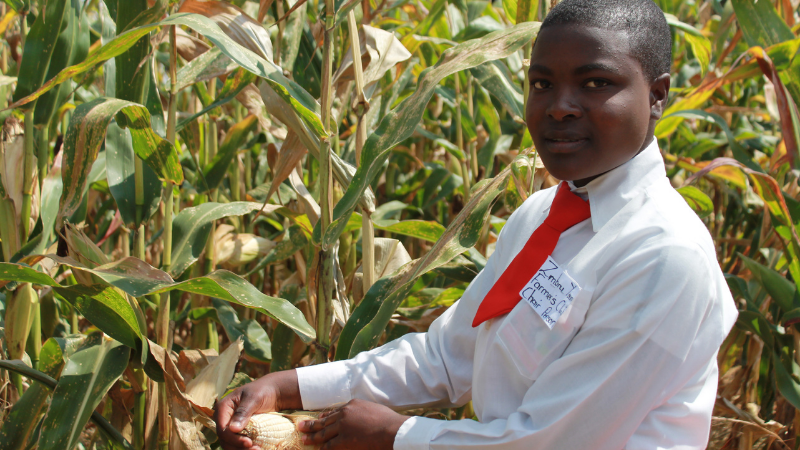by Zimbabwe Farmers Union (ZFU)
Description
More than 70 per cent of the population in Zimbabwe relies on agriculture for its livelihood. The sector provides the best prospects for large-scale food security, economic development and poverty eradication. This key sector is now under increasing threat from climate change. Agriculture both affects and is affected by climate change. No other sector is more climate-sensitive. The changing global climate threatens agricultural systems, livelihoods and the environment worldwide. Particularly vulnerable are the millions of smallholder farmers in Zimbabwe with limited means for coping with the risks posed by a changing climate. Rain-fed agricultural systems on which most of them depend will be adversely affected by extreme weather conditions and events (heat stress, droughts, floods), which are expected to increase in frequency and intensity. The proliferation of pests and diseases in areas where they have typically not been prevalent will also have severe negative impacts on productivity. There is an urgent need to support adaptation measures by such farmers and other stakeholders that will increase the sector’s resilience to a changing climate.
Although the causes of climate change are primarily from the use of fossil fuel, the agriculture sector is also culpable. The sector directly accounts for about 14 per cent of global greenhouse gas (GHG) emissions, and indirectly much more as agriculture is also the main driver of deforestation and other land-use changes that account for an additional 17 per cent. The responsibility of various categories of farmers is however substantially different. Although agriculture’s potential for climate change mitigation still remains to be fully understood, there is growing consensus that emissions reduction and removal of greenhouse gases (mitigation) from agriculture will be necessary if global mitigation efforts are to be successful.
While climate change introduces new challenges to food and agricultural production, in Zimbabwe, new opportunities have emerged for the agricultural sector. The renewed interest in conservation agriculture is one such opportunity.
Zimbabwe Farmers Union sought to harness this momentum to lead a transition to climate-smart agriculture by promoting large scale adoption (scaling-up) of this practice. This intervention facilitated farmer-led scaling up of conservation agriculture by smallholder farmers in Zimbabwe.
Conservation Agriculture (CA) is an option that has great potential. This farming technology makes more efficient use of natural resources through integrated management. Through the application of the three main principles of reducing soil disturbance, maintaining a permanent soil cover and practising crop rotations, CA improves the soil’s physical and chemical properties and reduces run-off and soil erosion while increasing water infiltration. As such the practice has major advantages in dealing with water stress in cropping systems. CA has been shown to improve drought tolerance for crops, increasing yields and encouraging diversified cropping systems that are accompanied by significant environmental benefits.
Results
Conservation Agriculture (CA) is being practised to varying scales in Zimbabwe. The area under CA in Zimbabwe represents less than 1% of the global total. Adoption of the practice is poorest among smallholder farmers who are constrained by poor access to information, lack of assets and limited financing to support such investments. Unfortunately, these farmers are the most vulnerable to climate change and therefore needed urgent support to transform their production systems towards climate-smart agriculture. The role of ZFU in facilitating large scale adoption of CA is widely recognised by many stakeholders who concur that FOs can coordinate partnerships with both public and private players to support smallholder farmers.
ZFU implemented the best practice using demonstration plots that were hosted by school-based Young Farmers Clubs (YFCs). The immediate local community surrounding the school participated in the intervention by experiential learning at the demonstration plot by participating at Avery stage of the cropping cycle from land preparation to harvesting.
The farmers would then apply the CA technology at their individual household farms. Exchange visits were incorporated into the event through the holding of field days at the best performing demonstration plot to foster peer learning.
The resources for the intervention were from NORAD through the “Southern African Confederation of Agricultural Unions”.
The intervention impacted 600 young farmers and 8000 community farmers who are gradually shifting from conventional to CA. Yield level for the participating farmers improved from an average of 1 tonne/ha to 3tonne/ha. Interest in agriculture amongst the youths was increased. Equipment rings were introduced to benefit the participating communities.
Agricultural extension workers were trained in the various aspects of CA. Crop diversification, especially the use of legumes improved the soil and soil degradation is gradually slowing down.
Climate smartness*
Conservation agriculture is one of the most common climate-smart practices across all regions especially in maize crop according to Sova et al. (2018). Climate smartness of this practice is high considering its contribution to all pillars (adaptation, mitigation and productivity). Conservation agriculture is a practice that can be implemented more easily by the farmers themselves, which tend to be perceived as having a lower number of institutional, economic, information, social and environmental barriers.
Opportunities to strengthen synergies across CSA pillar include the combination with other practices such as agroforestry systems, crop rotation and fertilizer management, in order to increase smartness in the system.
According to Thierfelder et al. (2017), conservation agriculture systems maintain higher infiltration rates and conserve soil moisture, which helps to overcome seasonal dry spells.
For more information about CSA, in the study of the World Bank, CCAFS and CIAT (2018), it is possible to identify several
practices for Zimbabwe evaluated around 8 key criteria: Water, Carbon, Nitrogen, Energy, Knowledge / Info risk, Yield, Income and Soil.
* This is done in the framework of climate-smart agriculture (CSA) approach. Climate-smartness in agriculture means understanding impacts of climate change and variability along with the agricultural activity, which includes the planning of what crop to plant, when to plant, what variety to plant and what type of management practices are needed to reduce the impact on the environment (e.g. emissions reduction), maintain or increase productivity (e.g. yields) while increasing resilience and improving livelihoods.


